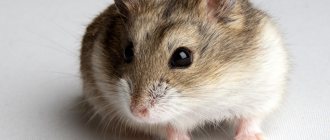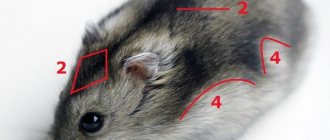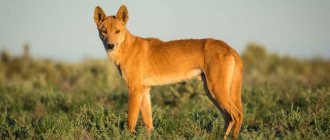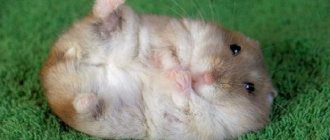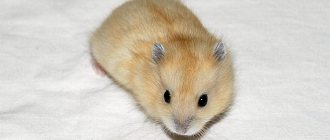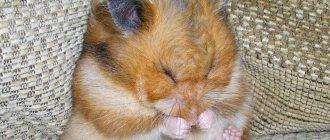Dangerous for crops and humans
- Fact:
A male with a tail reaches a length of 35-39 cm and a weight of up to 700 g. - Fact 2:
The wild hamster is distributed throughout the globe. - Fact 3:
Litters are large - 6-18 cubs. - Fact 4:
Hamster burrows are up to 150 cm deep and 800 cm wide.
There is no need to confuse that cute creature that lives in your home in a cage as a pet and its wild brother, who lives in any territory, from steppes to mountains, from forests to vegetable gardens. The most disturbing thing from the first is the habit of running on a wheel at night and making some noise in the sleepy silence of the apartment. The second one is quite dangerous, and not only to the future harvest, but also directly to humans.
External characteristics and description
The wild species is quite similar to its domestic counterpart. But their dimensions are completely different. The male with a tail reaches a length of 35-39 cm and a weight of up to 700 g. The female is a little smaller, but also very impressive.
The body of such an animal is round, without a neck, it seems that the head is planted directly on the shoulders. The body is covered with dense hair with undercoat. The animal's ears are small, and its limbs are short, but very strong. The claws are hard and sharp, just right for digging holes or holes in the ground. Teeth are also strong and are regularly worn down and renewed throughout their life cycle.
Attention! The bite of a wild hamster is very dangerous. Not only do his teeth leave wounds with jagged edges, he is also a carrier of infectious diseases.
The muzzle is equipped with stiff mustaches and black beads of shiny eyes. The color of the animal is varied.
Most common:
- Brown;
- Yellow.
Less common:
- Black.
- Spotted.
- White.
How does a field hamster overwinter?
When cold weather sets in, the karbysh remains in its hole, hibernating. He wakes up periodically to eat. The rodent comes to the surface only after the final onset of warmth, when the snow has completely melted.
Karbysh is not afraid of low temperatures; he is well hidden from them in his underground passages. The dwelling is arranged carefully; it is a combination of passages, nests and rooms. The burrow can reach 8 m in width and up to 1.5 m in depth. The hamster breaks through on average up to 10 burrows, some of which are false. Because of this, the process of expelling him from the shelter is much more difficult.
Reproduction
The wild hamster is distributed throughout the globe. He is not afraid of drought, cold, rain. Its hole reliably protects the animal from any weather. The main condition for a hamster to settle is the availability of food nearby. Therefore, the rodent prefers places near vegetable gardens, fields, orchards, etc. They fearlessly approach cultural plantings in vegetable gardens and summer cottages, replenishing supplies through human labor.
Sexual activity in hamsters is at a very high level. Maturity occurs at the age of 4.5-5 months. The male is polygamous. His family is a “harem” with several “wives” . The hamster's offspring are born helpless, blind and bald, but they grow rapidly and soon actively replenish the hamster family.
Cubs appear in the spring, but if conditions permit, the hamster is capable of breeding more than once a year. The litters are large - 6-18 cubs. It is not surprising that the hamster population is growing literally exponentially.
Traditional methods
To get rid of hamsters in the countryside, what folk remedies do experienced gardeners use? We bring to your attention proven and effective folk methods that have been used by summer residents for decades.
Pest ash
Wood ash
The prepared substance must be poured into the burrows of the animals and sprinkled on the places where they move on the surface. As you know, wood ash contains alkali, a corrosive substance. As the animals move, the ash will irritate the surface of the paws. Rodents will lick off the black coating. This way the alkali will get into the mouth and stomach of the rodent. As a result, severe inflammation will begin, and the rodent will simply be forced to leave the area it has chosen.
Flour with alabaster
Mix both substances in equal proportions. Pour the mixture near each hole, and place a drinking bowl with water nearby. This substance has no odor, so the hamster will try it without any suspicion, and after that he will want to drink. After reacting with water, alabaster begins to harden inside the animal’s stomach. As a result of this, death occurs. Remember - you only need to use wheat flour to prepare this mixture.
Wine cork pieces
Crush the wine cork as finely as possible. Add the crushed pieces of bread to the crushed mixture. Then pour in a small amount of vegetable oil and stir. Place the prepared mixture near the entrance to the holes. When a substance enters the stomach, the plug begins to swell and get stuck in the intestines. All this ends in death for the pest.
Quicklime
Mix sugar with quicklime and pour the substance into the holes. The corrosive mixture, entering the stomach of a rodent, causes severe burns and death. Literally a quarter of an hour later the animal dies.
Nutrition and lifestyle
The wild variety of hamsters is omnivorous. But cereal crops remain preferred, as do plant-based foods: potatoes, peas, etc. Loves to eat seeds, wild herbs, and bush roots. If necessary, will not refuse insects, mollusks, crustaceans, smaller rodents such as mice or rabbits.
Rodent activity is at its peak at night. They prefer to spend the day in the cool of the hole. In winter it sleeps, but not all the time; it wakes up periodically to feed itself. It comes to the surface with the first warmth (March-April). The male hamster is friendly with his females during the mating season. The rest of the time is a clot of aggression towards everyone, including humans. Moreover, the animal does not choose its enemy based on size, attacking anyone who encroaches on its “personal” territory.
Lifestyle
Now you know what carbysh looks like - photos make it easy to identify this harmful rodent. This means it’s time to find out about his habits and lifestyle.
Although the karbysh is a wild animal, it still prefers to live closer to humans: in vegetable gardens, garden plots, arable land, and parks. Which is not surprising - the soil here is loose, which means it’s easy to dig a hole. But more importantly, there is always something to eat near a person.
The burrows these rodents dig are very deep and long. The depth of some reaches two meters, and the length, taking into account all the branches, is 5 meters. Here they live, winter, raise their young, and store supplies collected in the fall.
At the same time, karbysh are owners and loners. They never live in packs, preferring a solitary lifestyle, gathering in pairs only during mating. When a guest climbs into someone else's hole, an extremely brutal fight with the owner will begin, which usually ends, if not with the death of one of them, then at least with serious injuries.
They are most active at night. It is in the dark that the carbysh actively moves, feeds, and stores. During the day, he prefers to sleep in his hole, practically without leaving it, or being in close proximity to his home in order to have time to hide.
It feeds mainly on plant foods: root crops, cereals, young grass. But on occasion he does not refuse the animal. Thus, its diet is often supplemented by worms, even mice, lizards, frogs and small snakes, and insect larvae.
Differences from other species of the rodent order
- Cheek pouches. Elastic folded skin formations. They hold a volume of up to 50 g, inflating several times. Used to carry food and building materials.
- Biphasic stomach:
- The proventriculus is where food is processed by enzymes and acid to break down food.
- The stomach, where digestion takes place using gastric juice.
- Dimensions and level of aggression . Great danger to humans, especially children and animals.
Ultrasonic repellers
Another effective tool that helps remove carbys from the area is a rodent repeller. This method of pest control is the most humane and safe. The device emits high-frequency ultrasonic waves, the frequency of which changes at a speed of 60 times per second. For rodents, the sound produced becomes unbearable, and they try to move to another territory without a hostile sound signal. The following devices are especially popular:
- "Typhoon". Can be used over an area of up to 220 m. Operates with a wide sound beam. Works in two modes: silent and sound. The first is used in residential premises, the second is more effective and is used where people do not live.
- "Grad". It works silently. Emits simultaneously sound and ultrasonic waves. There is a built-in flickering beam.
- "Electrocat" The rodent repeller acts not only with sound waves, but also with light flashes. There is a special irritating signal that has the most effective effect on rodents.
To achieve better results in the fight against underground pests, some gardeners bury an ultrasonic device in the ground and turn it on. According to them, karbysh leave the garden plot in a short time.
Harm to farms
The extent of the damage is simply enormous! Farmers, summer residents, and gardeners are groaning from the invasions of wild hamsters. Complete unpretentiousness, rapid population growth, and the ability to build complex burrow shelters make it very difficult to fight this malicious and embittered animal. Hamster burrows are up to 150 cm deep and 800 cm wide! They “dispossessed” the hamsters’ dwellings, where there were reserves of 90 kg!
But the destruction of crops is far from the only way a rodent can harm humans. Its bite infects the victim, which includes people, pets, and livestock, with 30 different types of infections, many of which are fatal! Ectoparasites living in animal fur are just as dangerous. Fleas are the same carriers of diseases as their carrier.
Why is a wild hamster dangerous for humans?
Like most wild rodents (voles, mice, rats, etc.), the field hamster is dangerous to humans because it is a carrier of dangerous infectious diseases. Pathogenic microorganisms are contained in saliva, which is why a karbysh bite can be very dangerous.
In captivity, due to the absence of natural enemies, the lifespan of carbish can increase to 5 years. You won’t be able to pick up a forest animal, much less play with it. When kept at home, the degree of aggression of a wild animal decreases somewhat. But he will never be grateful to the person who feeds him. A wild hamster does not tolerate being in a confined space very well, especially with any kind of proximity.
- Man, I’m warning you on good terms - let go! I will not live in a cage!!!
If a black hamster is kept in a cage, due to insufficient motor activity, it develops physical inactivity and its vitality decreases very quickly.
Photos
Control measures and how to get rid of them in the country house or garden
- One of the oldest and most proven methods is flooding holes . True, you will have to look for and block all the exits, except one, into which you will have to pour water until the rodent crawls out. Then he can be caught. The disadvantage of this method is that. that it is not always possible to find all the exits from the home. Then the hamster will simply get out where you won’t see him and hide with impunity.
- Manual excavation of a hole and catching . Disadvantage: danger of attack, bite and labor-intensive in terms of time and effort.
- Hunting for a hamster with pets . Dogs and cats are capable of catching a rodent, but then the dog will trample all the plantings. A hamster can bite and infect pets. Minus: large sizes are not suitable for all pets.
- Traps . Traps and various devices for catching. Minus: it is not always possible to determine where the animal is moving.
- Poison . Bait with poison can be scattered around the garden. Cons: May be eaten by pets or birds. The hamster population cannot be greatly reduced in this way.
- Ultrasound . Effective, but very expensive. Disadvantage: difficult to cover a large enough area.
The wild rodent is not only fearless, but also very cunning and agile. Fighting it is not an easy task, but it is necessary for your safety and the safety of the harvest, into which so much work is invested.
The main enemy of the forest hamster
Oddly enough, the main enemies of the karbysh are not forest animals and birds that hunt sinkers (owls, for example), but humans. It is he who causes the greatest damage to the population, exterminating the forest hamster in order to protect his crop from destruction. In the USSR, even the propaganda poster was appropriate:
In a moment of danger, a wild hamster boldly attacks an enemy, even if it is significantly larger in size, including a person. You may have just watched one video, but here's another one for you:
I apologize in advance for the profanity in the video...
Before attacking, the animal tries to intimidate the enemy: it makes sharp, loud sounds, and chatters its teeth.


